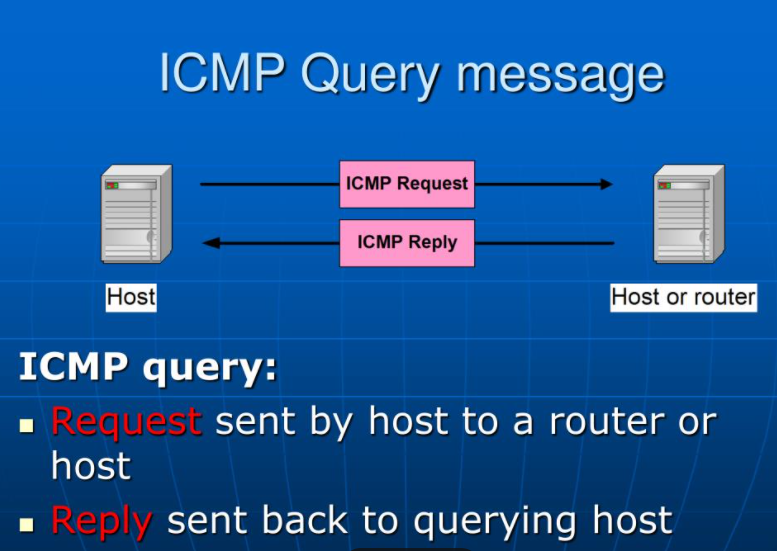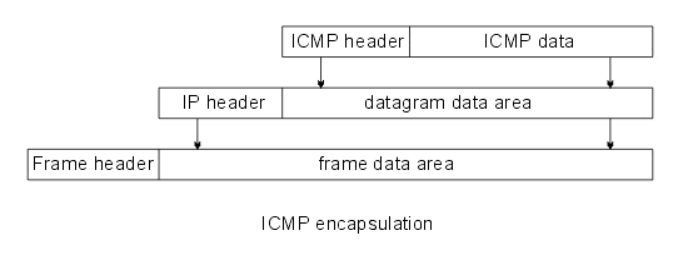ICMP协议学习总结
ICMP协议总结
ICMP是“Internet Control Message Protocol”(Internet控制消息协议)的缩写。
它是TCP/IP协议族的一个子协议,用于在IP主机、路由器之间传递控制消息。
控制消息是指网络通不通、主机是否可达、路由是否可用等网络本身的消息。
这些控制消息虽然并不传输用户数据,但是对于用户数据的传递起着重要的作用。
1.ICMP请求与应答过程

2. ICMP报文格式

3.ICMP报文与IP包的关系示意图(封装过程示意图)

4. ICMP协议应用,即常见PING反馈结果:
连接建立成功: Reply from ....
目标地址不可达:Destination host unreachable.
请求时间超时: Request timed out.
未知主机名: Unknown host ...
从外网摘录,供参考:
What is the ICMP (Internet Control Message Protocol)?
In order to be able to exchange status information or fault messages, nodes in TCP/IP networks access the Internet Control Message Protocol (ICMP). In particular, application servers and gateways (routers) use the IP extension to display notifications of datagram problems to the packages’ sender. The structure, mode of operation and classification in the internet protocol stack were specified in RFC 792 in 1981 RFC 792. For version 6 of the internet protocol RFC 4443 has been defined as the specific implementation of ICMPv6.
By definition ICMP is a stand-alone protocol, even if the various notifications are integrated into regular IP packets. To this end, the Internet Protocol treats the optional extension as a higher layer protocol. Lots of frequently-used network services, such as traceroute or ping, are based on the ICMP protocol.
How does ICMP work?
To understand how the protocol works, you first need to look at the structure of the ICMP, or the header. This is directly linked to the IP header, which is marked by the protocol number 1 or 58 (ICMPv6) in the IP field “protocol.” The header data area of the Internet Control Message Protocol itself is limited and has the following form:

The first 8-bit “Type” field determines what type of notification the ICMP packet is. This information can be specified with the following “code” field, which is also 8 bits long. For example, an ICMP type 3 message specifies that the destination of the data packet is unavailable, while the code specifies this information to determine whether it was the destination network (0), the desired host (1) or the targeted port (3) that did not respond to the previous request. The ICMP checksum follows the information about the message type, and ensures the accuracy of the notification. This is done the same way as other standard protocols’ checksums (IP, UDP, TCP).
Finally, the ICMP files are built and structured differently depending on the respective type and the triggering instance. The IP header often contains a listing of the first 64 bits of the data packet, which are responsible for the error message or the status query. When so-called ICMP tunneling takes place, this field is misused for sending useful data under firewalls’ radars or for establishing an encrypted communication channel between two computers.
What kinds of ICMP packets are there?
Due to the 8 bit field length, 256 different ICMP messages are theoretically possible, with about 40 of them being fixed (including some obsolete representatives) and some blocked for experimental use.
The majority of the numbers (42-252) are not currently assigned, but are reserved in principle. The IANA (Internet Assigned Numbers Authority) are responsible for assigning the numbers, and also regulate the assignment of IP address spaces and ports. We have summarized some of the most important packet types based on the Internet Control Message Protocol in the following table:
|
ICMP type |
ICMPv6 type |
Type name |
Code |
Description |
|
3 |
129 |
Echo Reply |
|
Test for presence by answering a network ping |
|
|
1 |
Destination Unreachable |
0–15 |
An ICMP message that informs, among others things, the inaccessibility that specific components (network, protocol, port, host) in the field “code” have with routing problems or firewall blocking. |
|
5 |
137 |
Redirect Message |
0–3 |
Notifying the redirection of a packet for the specified network (0), the specified service and the network (2), or the specified service and host (3). |
|
8 |
128 |
Echo Request |
|
Network ping |
|
9 |
134 |
Router Advertisement |
|
Used by routers to communicate with different network clients. |
|
11 |
3 |
Time Exceeded |
0 oder 1 |
Status reports, that either report the lifespan (time to Live, TTL) of a packet (0), or the waiting time until the assembly of fragmented packets (1) has expired. |
|
13 |
13 |
Timestamp |
|
This provides the corresponding IP packet with a time stamp, which corresponds to the dispatch time and serves the synchronization of two computers. |
|
14 |
- |
Timestamp Reply |
|
Response message an ICMP timestamp that the addressee sends after receiving one. |
|
30 |
- |
Traceroute |
|
An outdated ICMP message type used to track the path of a data packet in the network: today, email requests and repetitions are mainly used for this purpose. |
Where ICMP and ICMPv6 are used
ICMP is crucially important in terms of communication within IP networks, and is used by routers in particular. However, servers and clients also make use of the Internet Protocol-coupled messages capabilities and in doing so, obtain important network information.
A common usage scenario is the so-called network ping, which can be executed via the command line of the respective operating system using applications of the same name. The simple but useful diagnostic tool is the easiest option to check the availability of a particular host on the network. To do this, ping sends an IP packet including the ICMP (v6) “Echo Request” (type 8 or 128). After receiving this packet, the receiver responds with a data packet containing the ICMP entry “Echo Reply” (type 0 or 129). If the system that the ping was sent to is unreachable, the last remaining reachable network station sends a response packet. This is also extended by an ICMP component: type 3 or 1 “Destination Unreachable.”
Routers in turn use ICMP for different purposes: per router advertisement (ICMP type 9; ICMPv6 type 134) they set, for example all active network users in regular intervals about their attendance and different network information knowledge. They store the received data in their cache and make the router the standard gateway. In addition, routers try to optimize the path of data packets in the network through ICMP redirects (Type 5 or 137). Using this message type, the network interfaces point a host to the existence of a better first hop (intermediate station) for sending IP packets.
ICMP Type
|
ICMP类型 |
|||||
|
TYPE |
CODE |
Description |
Query |
Error |
|
|
0 |
0 |
Echo Reply——回显应答(Ping应答) |
x |
||
|
3 |
0 |
Network Unreachable——网络不可达 |
x |
||
|
3 |
1 |
Host Unreachable——主机不可达 |
x |
||
|
3 |
2 |
Protocol Unreachable——协议不可达 |
x |
||
|
3 |
3 |
Port Unreachable——端口不可达 |
x |
||
|
3 |
4 |
Fragmentation needed but no frag. bit set——需要进行分片但设置不分片比特 |
x |
||
|
3 |
5 |
Source routing failed——源站选路失败 |
x |
||
|
3 |
6 |
Destination network unknown——目的网络未知 |
x |
||
|
3 |
7 |
Destination host unknown——目的主机未知 |
x |
||
|
3 |
8 |
Source host isolated (obsolete)——源主机被隔离(作废不用) |
x |
||
|
3 |
9 |
Destination network administratively prohibited——目的网络被强制禁止 |
x |
||
|
3 |
10 |
Destination host administratively prohibited——目的主机被强制禁止 |
x |
||
|
3 |
11 |
Network unreachable for TOS——由于服务类型TOS,网络不可达 |
x |
||
|
3 |
12 |
Host unreachable for TOS——由于服务类型TOS,主机不可达 |
x |
||
|
3 |
13 |
Communication administratively prohibited by filtering——由于过滤,通信被强制禁止 |
x |
||
|
3 |
14 |
Host precedence violation——主机越权 |
x |
||
|
3 |
15 |
Precedence cutoff in effect——优先中止生效 |
x |
||
|
4 |
0 |
Source quench——源端被关闭(基本流控制) |
|||
|
5 |
0 |
Redirect for network——对网络重定向 |
|||
|
5 |
1 |
Redirect for host——对主机重定向 |
|||
|
5 |
2 |
Redirect for TOS and network——对服务类型和网络重定向 |
|||
|
5 |
3 |
Redirect for TOS and host——对服务类型和主机重定向 |
|||
|
8 |
0 |
Echo request——回显请求(Ping请求) |
x |
||
|
9 |
0 |
Router advertisement——路由器通告 |
|||
|
10 |
0 |
Route solicitation——路由器请求 |
|||
|
11 |
0 |
TTL equals 0 during transit——传输期间生存时间为0 |
x |
||
|
11 |
1 |
TTL equals 0 during reassembly——在数据报组装期间生存时间为0 |
x |
||
|
12 |
0 |
IP header bad (catchall error)——坏的IP首部(包括各种差错) |
x |
||
|
12 |
1 |
Required options missing——缺少必需的选项 |
x |
||
|
13 |
0 |
Timestamp request (obsolete)——时间戳请求(作废不用) |
x |
||
|
14 |
Timestamp reply (obsolete)——时间戳应答(作废不用) |
x |
|||
|
15 |
0 |
Information request (obsolete)——信息请求(作废不用) |
x |
||
|
16 |
0 |
Information reply (obsolete)——信息应答(作废不用) |
x |
||
|
17 |
0 |
Address mask request——地址掩码请求 |
x |
||
|
18 |
0 |
Address mask reply——地址掩码应答 |
|||





【推荐】国内首个AI IDE,深度理解中文开发场景,立即下载体验Trae
【推荐】编程新体验,更懂你的AI,立即体验豆包MarsCode编程助手
【推荐】抖音旗下AI助手豆包,你的智能百科全书,全免费不限次数
【推荐】轻量又高性能的 SSH 工具 IShell:AI 加持,快人一步
· TypeScript + Deepseek 打造卜卦网站:技术与玄学的结合
· Manus的开源复刻OpenManus初探
· AI 智能体引爆开源社区「GitHub 热点速览」
· 三行代码完成国际化适配,妙~啊~
· .NET Core 中如何实现缓存的预热?